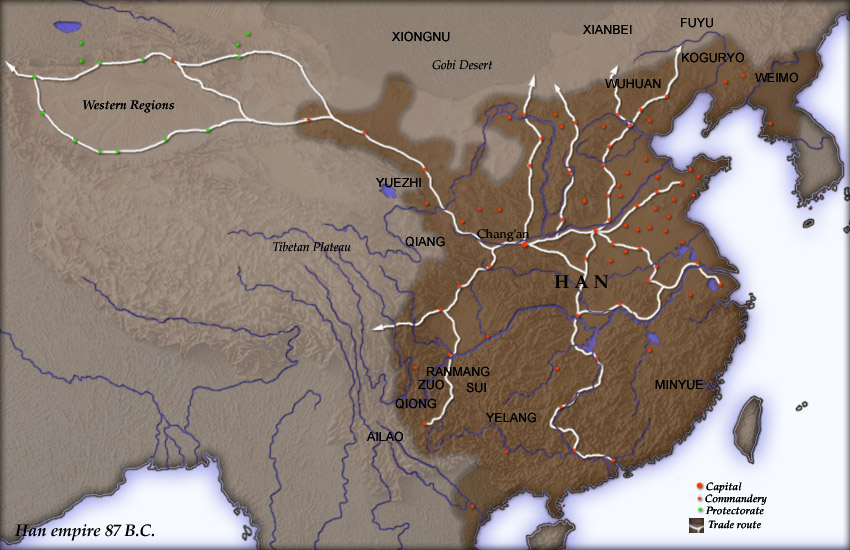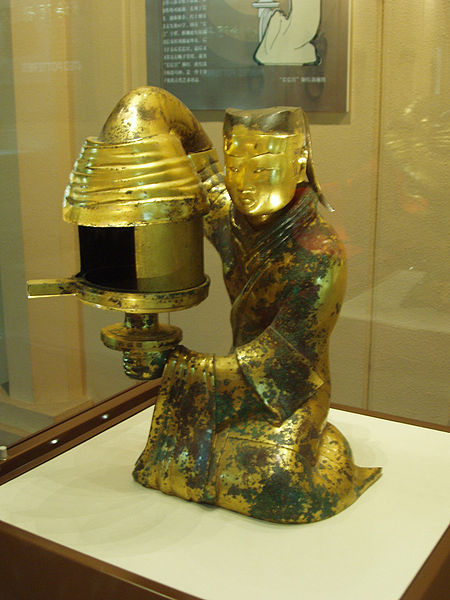The Han Dynasty (206 BC – AD 220) was established when Prince of Han, Liu Bang, crushed the Imperial Army of Qin in Wei Valley. The conquest was originally a part of a mass rebellion that arose after the death of the First Qin Emperor. The people were disappointed and unhappy with the despotism of the Qin successors and their aristocratic rule in the empire. However, although Chinese historians describe the Han Dynasty as an era of reforms, there are proofs that the Han followed most of the rules of the Qin Dynasty, only progressively integrating Confucianism into the empire. This led to major economic expansion, mutable affairs with those who are living in prairies, establishment of the Han Palace through civil service, declining the empire’s embrace on slavery and the ascent of merchants.
Qin Penal System Retained
Under the new empire with integrated Confucianism, penal system used during the Qin dynasty was still used for commoners. However, aristocrats and those people belonging to the elite families were judged according to ideology of Confucianism with the rationalization for a separate set of standards as they were strictly educated and refined by culture. As an alternative, the Han emperor could sentence for both social classes. It was viewed that power alone was not enough to rule, so the Han emperor employs the aid of Confucian philosophers for moral guidance. There are historical accounts of high officials in the empire that were sentenced to death through decapitation.
Han Ruling System
When the Han vanquished the Qin, the capital was transferred to Chang’an. Han emperor Liu Bang preserved most laws and principles of government from the Qin, knighted his friends and endowed them with fiefdoms. However, fiefdoms were sub-grouped into prefectures and provinces. Basically, the power of the Han dynasty was heavily based on the direct regulation of the people by the empire.
Han Expansion and Destruction
In the vein of the Qin dynasty before the second empire, the primary goal of the Han dynasty was to unite the whole China. This aspiration, however, resulted to the final destruction of the fiefdoms and the demise of the empire. This crucial process was ultimately concluded during the reign of Han Emperor Wudi (156 BC – March 29, 87) – an era of vast military development. Emperor Wudi conquered parts of modern Kyrgyzstan, Vietnam and Korea and vanquished the Huns to the Gobi desert. This seventh Emperor of the Han dynasty moved an approximate two million Chinese to the northwestern part of the empire to ensure colonization.
Han Dynasty Trade and Economy
This expansion of the Han dynasty was significant since this led to commercialization and trade with people within Asia. The famous Silk Road was developed during this dynasty. Actually, the Silk Road was composed of different route through the mountains and valleys that merchants, traders and government officials followed for safe travel away from robbers and bandits. Agriculture developed with the emergence of complicated tools made from iron that are superior in quality.
Better irrigation systems were enhanced to aid in the colonization of the northern region of China. The Empire also invested on conducting study on agriculture and crop rotation was used. Iron and salt, two biggest products in the economy of the empire, were monopolized for at least a century. Silk production and coppery were also significant economic activities during the Han dynasty.
Han Dynasty Education
Education was also given emphasis during this era as a new class of philosophers and educated elite were hailed. This led to assemblage of different important books such as anthologies, history accounts and encyclopedia. The most famous and important book of the Han dynasty is the Book of the Mountains and Seas. This atlas-like book includes every information known at the era about geography and topography of known lands, ecology, zoology and botany and famous myths.
Sima Qian, a great Chinese historian, completed his famous book, “The Records of the Great Historian.” This book turned out to be the model for history book. This is the known attempt in China to keep recorded past in a tangible form.
The Two Distinct Dynasties within the Han Dynasty
The Han Dynasty was actually composed of two distinct dynasties. It was considered as one dynasty by most Chinese since the second dynasty was established by a ruler from the Han who claimed that he had re-established the glory of the Empire under the Han. The first Han Dynasty was deposed when elite and rich families including merchants became more influential in the government. The rich families forged rich allegiance through marriage and selected officials that would take care of their interests.
When the Han Emperor Yuandi died, he was succeeded by his empress instead of the crown prince. The new empress succeeded in giving out government positions to all her relatives. In the long run, the Empress’ nephew, Wang Mang, finally declared himself as the next Han emperor of Xin. The emergence of Wang Mang as Emperor was remarkable since he was widely supported by the public and established the ceremonial imperial succession wherein a seal of a precious bejeweled stone was passed to the successor. After that, whoever holds the seal became the recognized emperor. However, Wang Mang was toppled by an underground society of peasants and laborers called as Che Mei or Red Eyebrows, but known to the Western history as the Triads.
Descendants and old members of the original Han dynasty joined in the rebellion. It was really the armed soldiers of the Han nobilities who defeated and eventually killed Wang Mang. Then, the leader of the Han nobles, Liu Xiu, became Emperor Guang Wudi.
The second Han dynasty gained more success with foreign affairs. This success was largely credited to luck rather than strategic governance and international policy. The nomadic people, the Huns, earlier was the most treacherous rivals of the Chinese Empire, were conquered by the Wuhuan. Most of the Huns migrated to the southern region of China and eventually were integrated in the empire.
The Huns tried to re-unite and establish a considerably large empire composed of the lands of the Turks. So the Han Empire started a crusade to these lands and eventually monopolized the trade. This was a quick conquest even though it was during the time of transition of imperial power from Han Emperor Mingdi to Han Emperor Changi.
The End of the Han Dynasty
The Han Dynasty was considered as a successful dynasty in terms of economy, military expansion and social policies. However, the Han Dynasty was toppled by the Yellow Turbans, another secret society of peasants. The Empire defeated the Yellow Turbans but the whole empire was separated into three Kingdoms.

